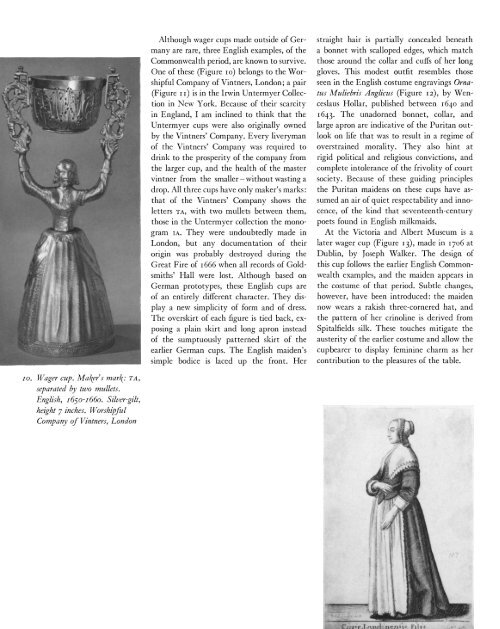Wager Cups - Metropolitan Museum of Art
Wager Cups - Metropolitan Museum of Art
Wager Cups - Metropolitan Museum of Art
You also want an ePaper? Increase the reach of your titles
YUMPU automatically turns print PDFs into web optimized ePapers that Google loves.
io. <strong>Wager</strong> cup. Maker's mark: TA,<br />
separated by two mullets.<br />
English, z650o-66o. Silver-gilt,<br />
height 7 inches. Worshipful<br />
Company <strong>of</strong> Vintners, London<br />
Although wager cups made outside <strong>of</strong> Ger-<br />
many are rare, three English examples, <strong>of</strong> the<br />
Commonwealth period, are known to survive.<br />
One <strong>of</strong> these (Figure i o) belongs to the Wor-<br />
shipful Company <strong>of</strong> Vintners, London; a pair<br />
(Figure i i) is in the Irwin Untermyer Collec-<br />
tion in New York. Because <strong>of</strong> their scarcity<br />
in England, I am inclined to think that the<br />
Untermyer cups were also originally owned<br />
by the Vintners' Company. Every liveryman<br />
<strong>of</strong> the Vintners' Company was required to<br />
drink to the prosperity <strong>of</strong> the company from<br />
the larger cup, and the health <strong>of</strong> the master<br />
vintner from the smaller - without wasting a<br />
drop. All three cups have only maker's marks:<br />
that <strong>of</strong> the Vintners' Company shows the<br />
letters TA, with two mullets between them,<br />
those in the Untermyer collection the mono-<br />
gram IA. They were undoubtedly made in<br />
London, but any documentation <strong>of</strong> their<br />
origin was probably destroyed during the<br />
Great Fire <strong>of</strong> i666 when all records <strong>of</strong> Gold-<br />
smiths' Hall were lost. Although based on<br />
German prototypes, these English cups are<br />
<strong>of</strong> an entirely different character. They dis-<br />
play a new simplicity <strong>of</strong> form and <strong>of</strong> dress.<br />
The overskirt <strong>of</strong> each figure is tied back, ex-<br />
posing a plain skirt and long apron instead<br />
<strong>of</strong> the sumptuously patterned skirt <strong>of</strong> the<br />
earlier German cups. The English maiden's<br />
simple bodice is laced up the front. Her<br />
straight hair is partially concealed beneath<br />
a bonnet with scalloped edges, which match<br />
those around the collar and cuffs <strong>of</strong> her long<br />
gloves. This modest outfit resembles those<br />
seen in the English costume engravings Ornatus<br />
Muliebris Anglicus (Figure 12), by Wenceslaus<br />
Hollar, published between i640 and<br />
I643. The unadorned bonnet, collar, and<br />
large apron are indicative <strong>of</strong> the Puritan outlook<br />
on life that was to result in a regime <strong>of</strong><br />
overstrained morality. They also hint at<br />
rigid political and religious convictions, and<br />
complete intolerance <strong>of</strong> the frivolity <strong>of</strong> court<br />
society. Because <strong>of</strong> these guiding principles<br />
the Puritan maidens on these cups have assumed<br />
an air <strong>of</strong> quiet respectability and innocence,<br />
<strong>of</strong> the kind that seventeenth-century<br />
poets found in English milkmaids.<br />
At the Victoria and Albert <strong>Museum</strong> is a<br />
later wager cup (Figure I3), made in 1706 at<br />
Dublin, by Joseph Walker. The design <strong>of</strong><br />
this cup follows the earlier English Commonwealth<br />
examples, and the maiden appears in<br />
the costume <strong>of</strong> that period. Subtle changes,<br />
however, have been introduced: the maiden<br />
now wears a rakish three-cornered hat, and<br />
the pattern <strong>of</strong> her crinoline is derived from<br />
Spitalfields silk. These touches mitigate the<br />
austerity <strong>of</strong> the earlier costume and allow the<br />
cupbearer to display feminine charm as her<br />
contribution to the pleasures <strong>of</strong> the table.

















